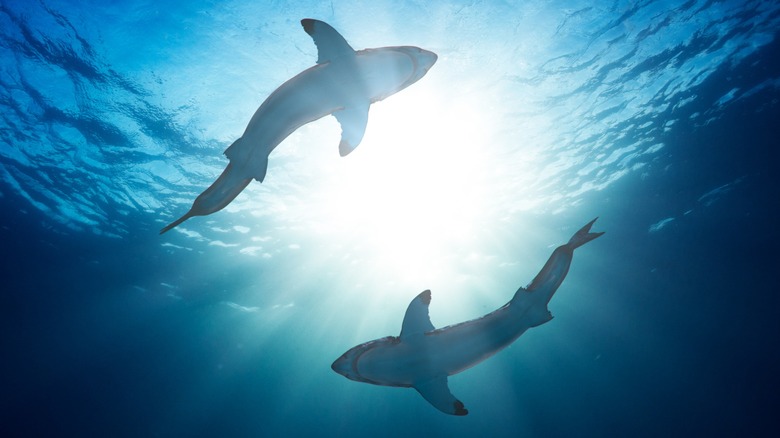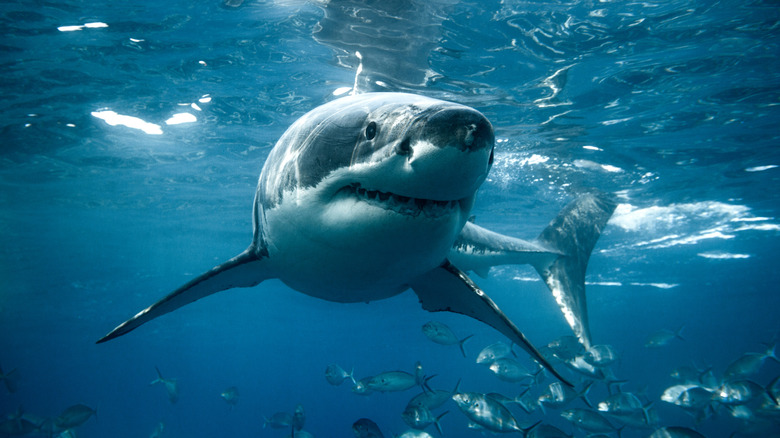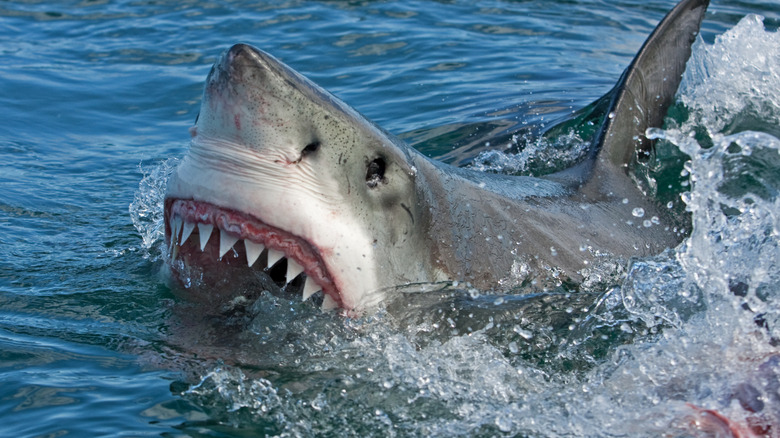The Best Place To See Great White Sharks When In Massachusetts
Great white sharks (Carcharodon carcharias), also referred to as just white sharks, are fascinating creatures, so much so that millions of people tune in to watch Discovery Channel's Shark Week and National Geographic's SharkFest every year. While they're one of the most dangerous species in Florida, the best place to see them is actually in Massachusetts — Shark Alley along the Cape Cod shore to be more precise — and there's a good reason for that.
From May to October, migration patterns bring white sharks to Cape Cod waters around Chatham, Nauset Beach, and Monomoy Island — now one of the biggest seasonal aggregation sites in the world for these animals. They used to be rare, with some shark experts not encountering them near Cape Cod until 2004. Since then, the population has surged because prey populations have surged as well. As top predators in the food chain of saltwater fish, these animals eat seals (a favorite) and other marine mammals, fish, and invertebrates. The gray seal population has particularly flourished thanks to the Marine Mammal Protection Act of 1972, increasing to more than 30,000 seals by 2017 since basically being killed off in New England by the 1960s. And, the white sharks have followed the seals' scent trails.
From 2014 to 2018, Massachusetts' Division of Marine Fisheries collaborated with the UMass School for Marine Science and Technology and the Atlantic White Shark Conservancy to study the growth of the white shark population. This study has cataloged at least 300 individual sharks but estimate that about 800 visit the area.
What you need to know about great white sharks
Before visiting Cape Cod to look for white sharks, it's helpful to learn more about these apex predators. They're about 4 feet long when they're born, and they can grow to around 20 feet long and weigh more than 2 tons. However, the rate of growth is slow over the life cycle of a shark, taking about 26 years for males and about 33 years for females to mature fully.
Great white sharks have conical snouts, torpedo-shaped bodies, large first dorsal fins with pointed tips, and prominent keels (abdominal ridges) around the bases of their tails, which have a crescent shape. While these animals are brown to dark gray on top, they are named for their white underbellies. Usually, white sharks have black spots underneath their pectoral fins, too. One of the most interesting characteristics, though, is their broad, triangular teeth, which have unmistakable saw-like edges (serrations).
White sharks live in temperate and subtropical waters around the world, and their habitat preferences change as they age. Generally, pups and juveniles stay in near-shore waters, such as the nurseries in Southern California and Long Island, New York. As they grow and their diets change, they tend to migrate between sea lion and seal rookeries (nesting areas) and pelagic zones (open ocean water). Overall, though, white sharks prefer water temperatures between 50 and 80 degrees Fahrenheit.
How to spot a great white shark and stay safe
Now that you know what white sharks look like, spotting one (or more) could be as simple as going to a Cape Cod beach (binoculars optional) and watching the horizon. The Atlantic White Shark Conservancy has a Sharktivity app for Apple and Android devices, providing updated information about sightings so that you can choose the best spot. If you see seals nearby, there's a higher chance of sharks nearby as well.
The beach-side method takes some patience, and you aren't guaranteed to see anything, especially since these animals are independent for the most part. Plus, there are safety considerations to keep in mind if you decide to cool off in the water while you shark-watch. Paying attention to flags and signage warning about sharks being too close to the shoreline is essential. You also shouldn't go too far into the water or isolate yourself. Although sharks biting humans rarely occurs, it has happened before.
The best and safest way to see great white sharks around Cape Cod may be to join a guided charter or boat tour. Many of the operators — such as Down Cape Charters & Boat Rentals, Monomoy Sportfishing, and Outermost Harbor Marine — work with professional spotter pilots who fly above to find the animals and send the boat captains in the right direction. Unlike in other parts of the world, dumping chum to attract white sharks isn't permitted in Massachusetts waters, nor is cage diving.


